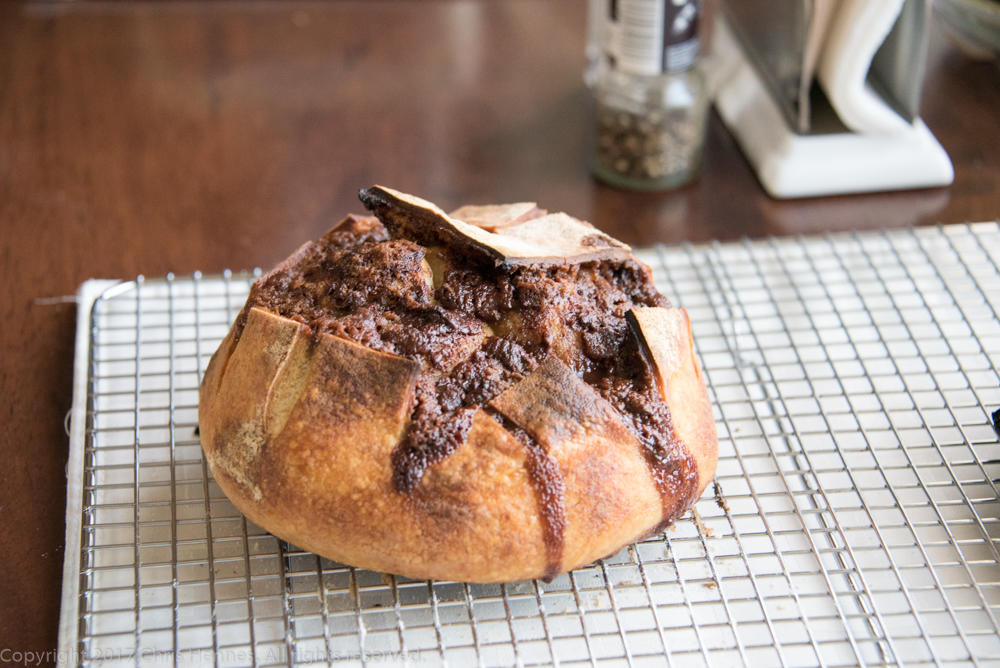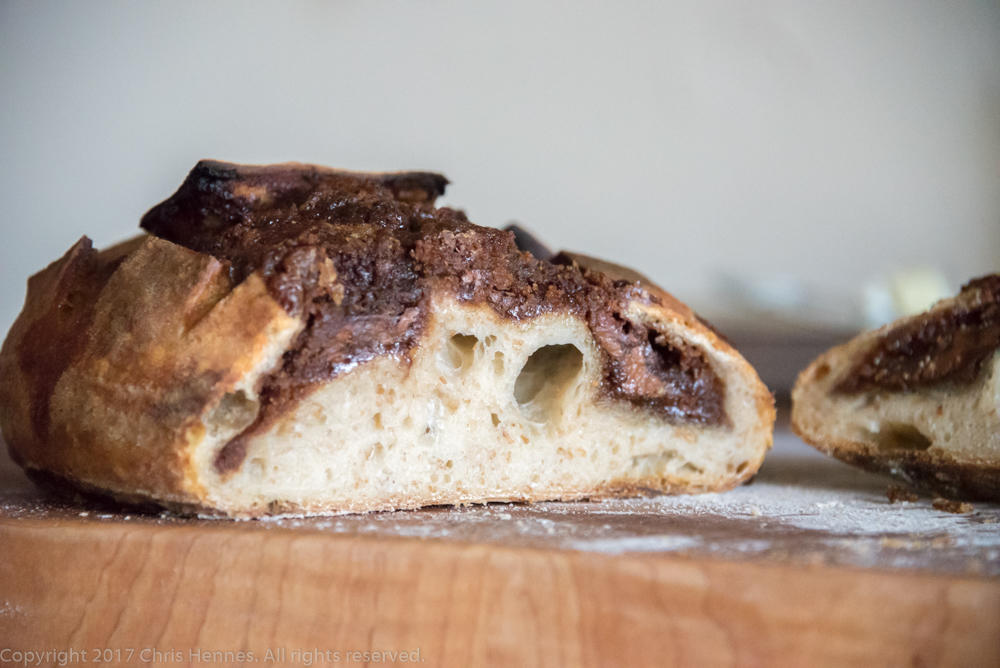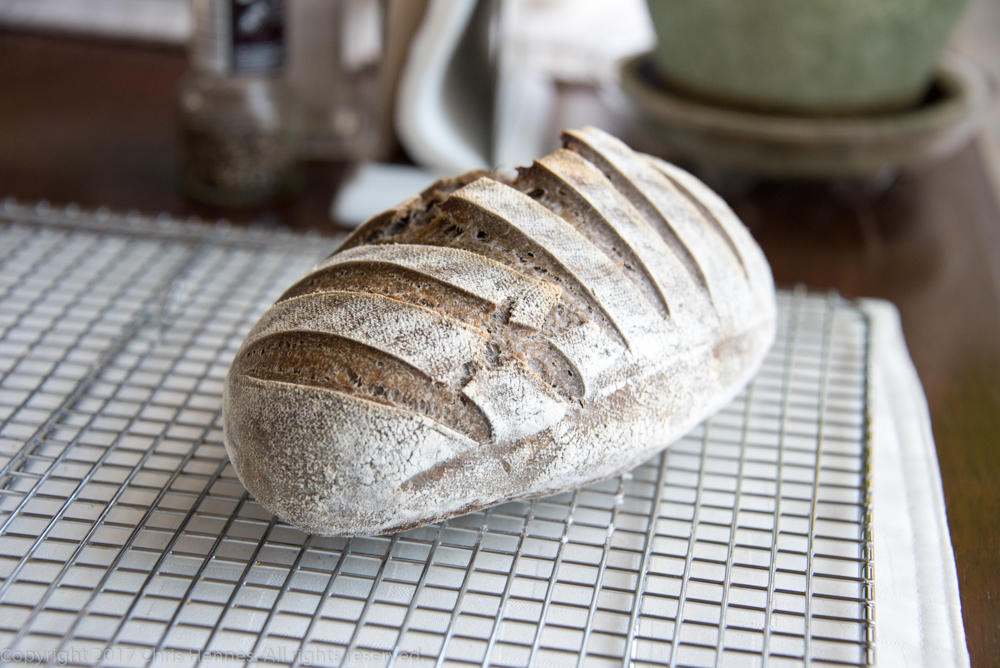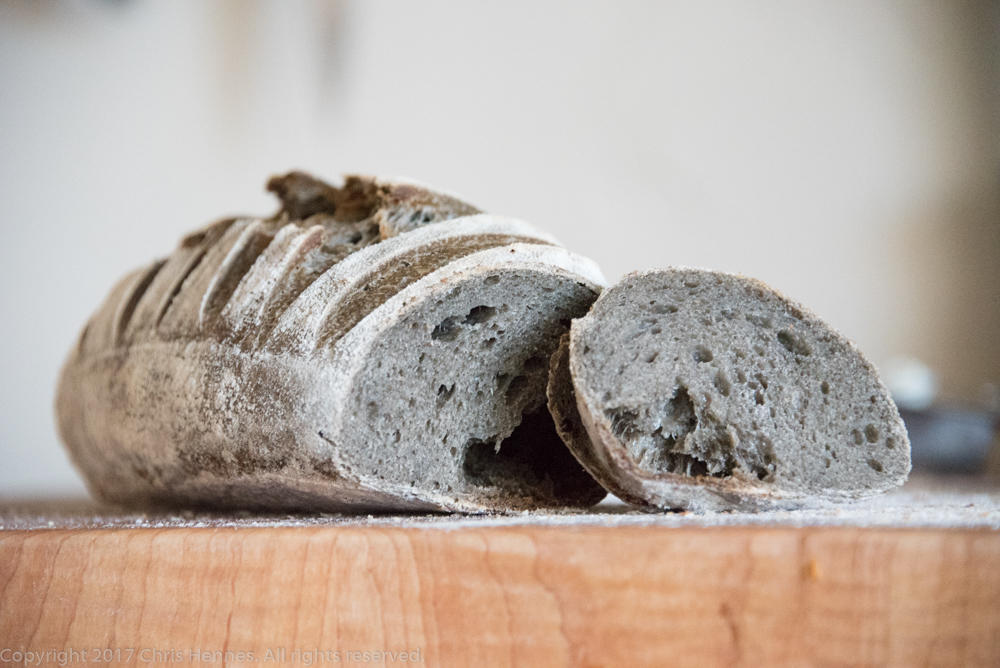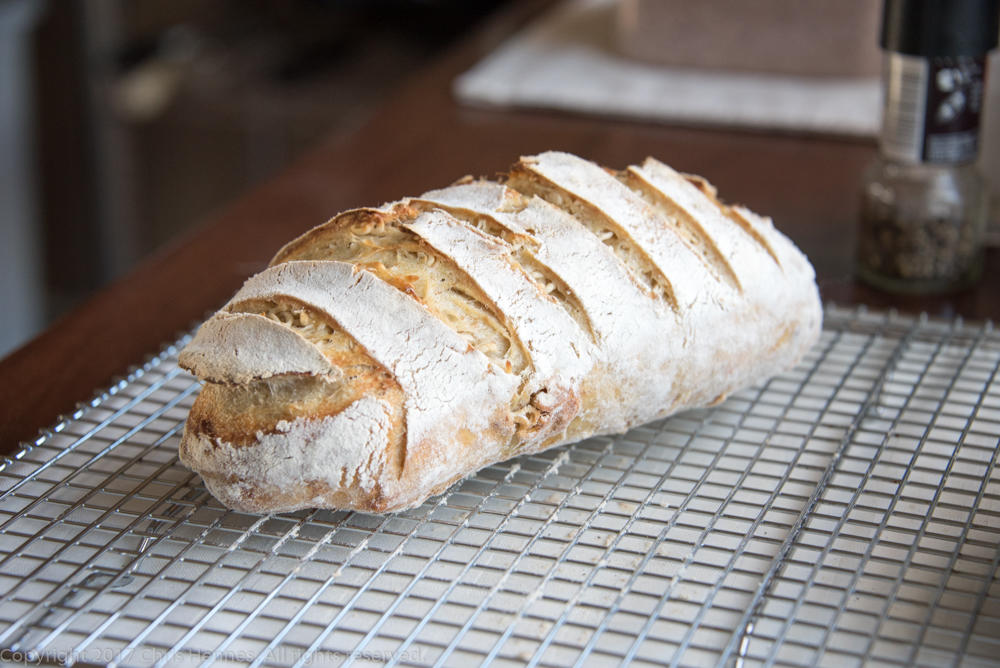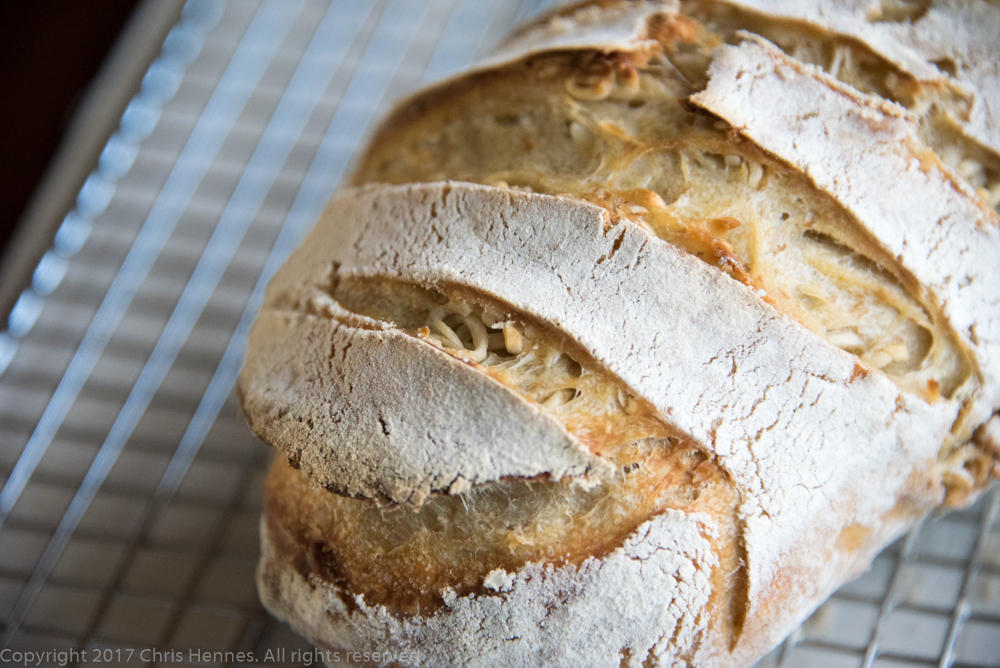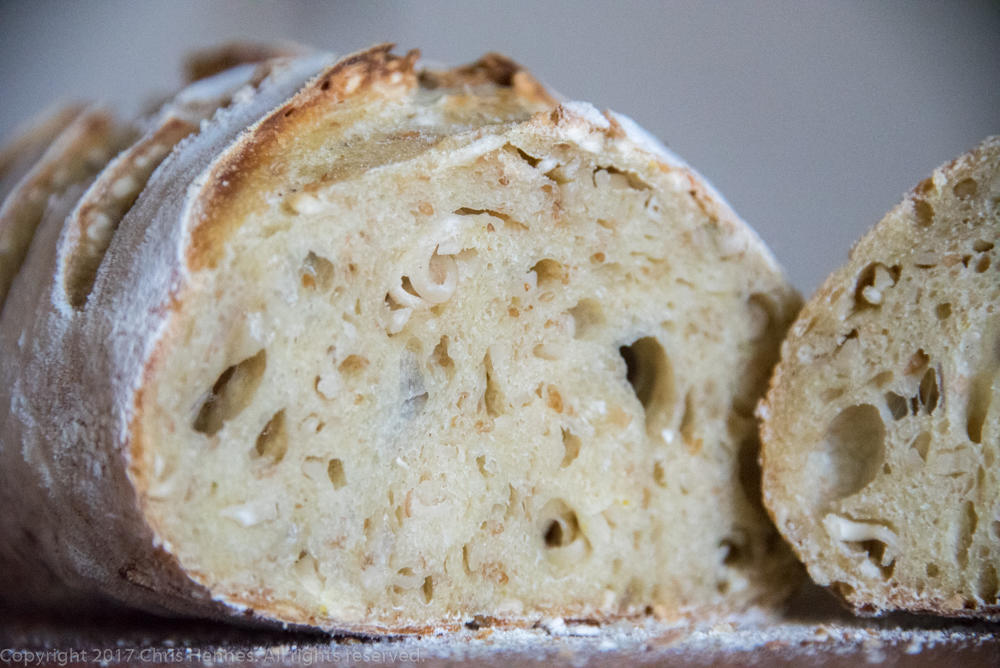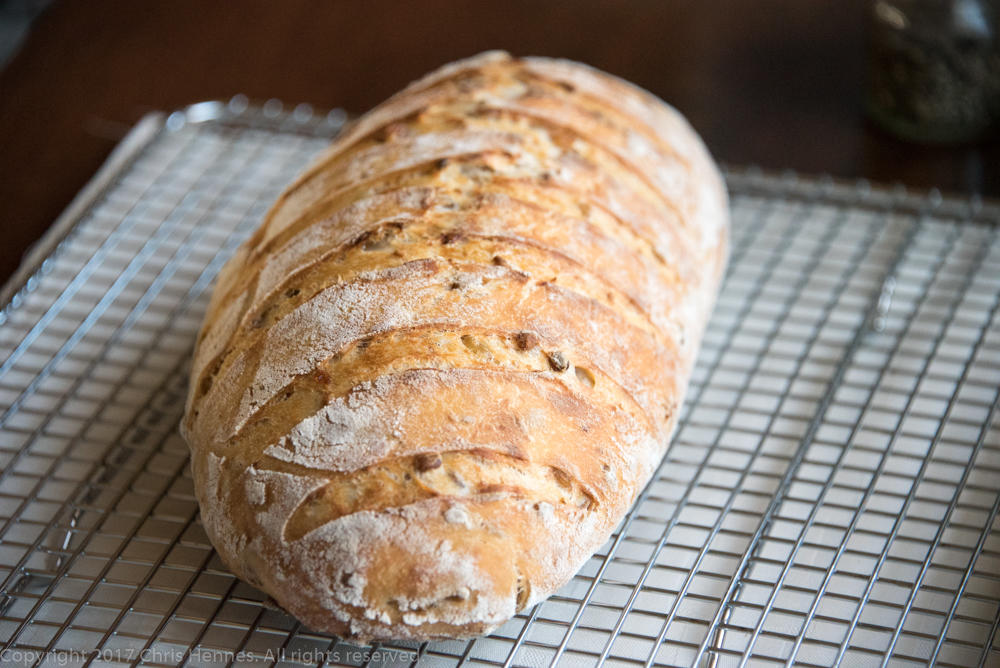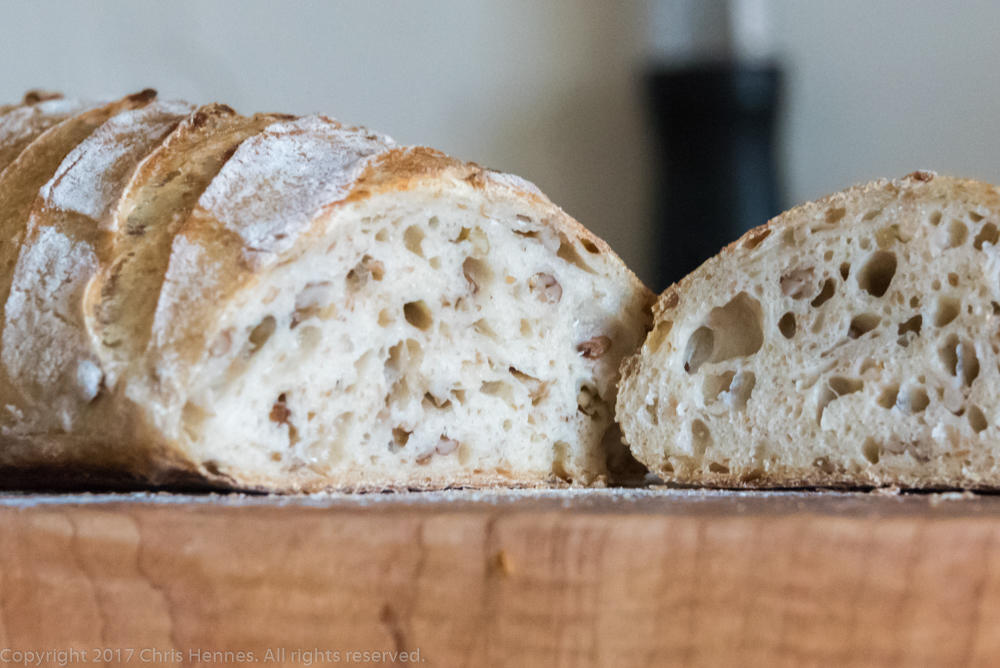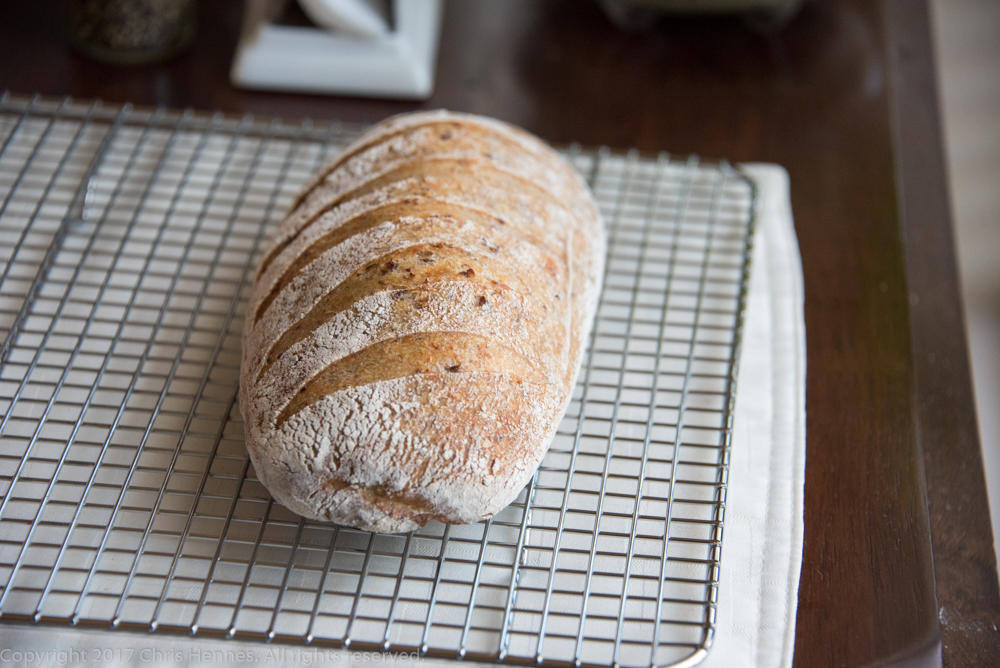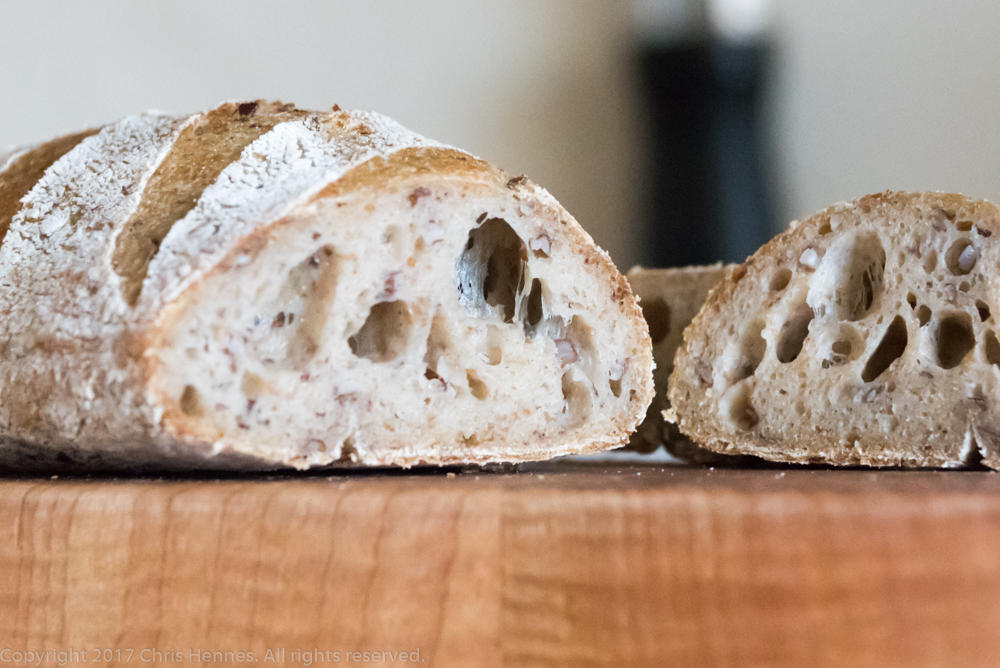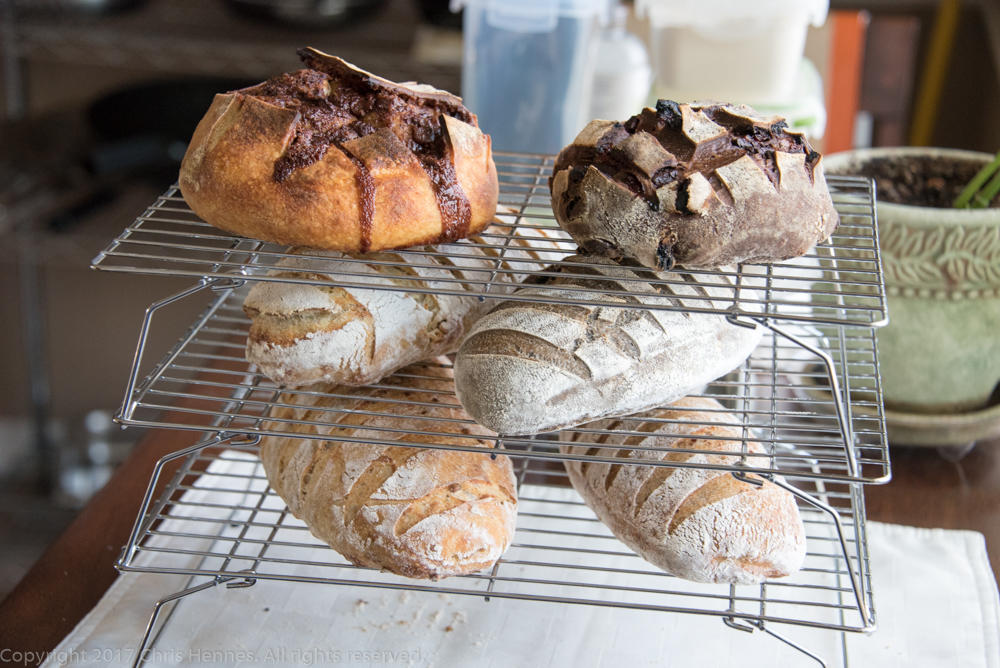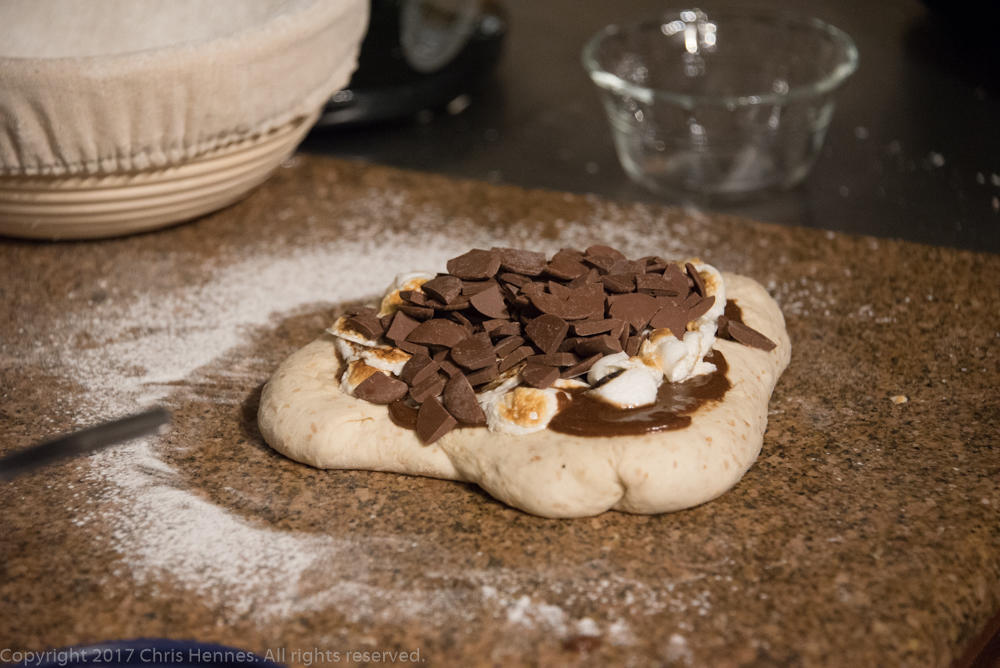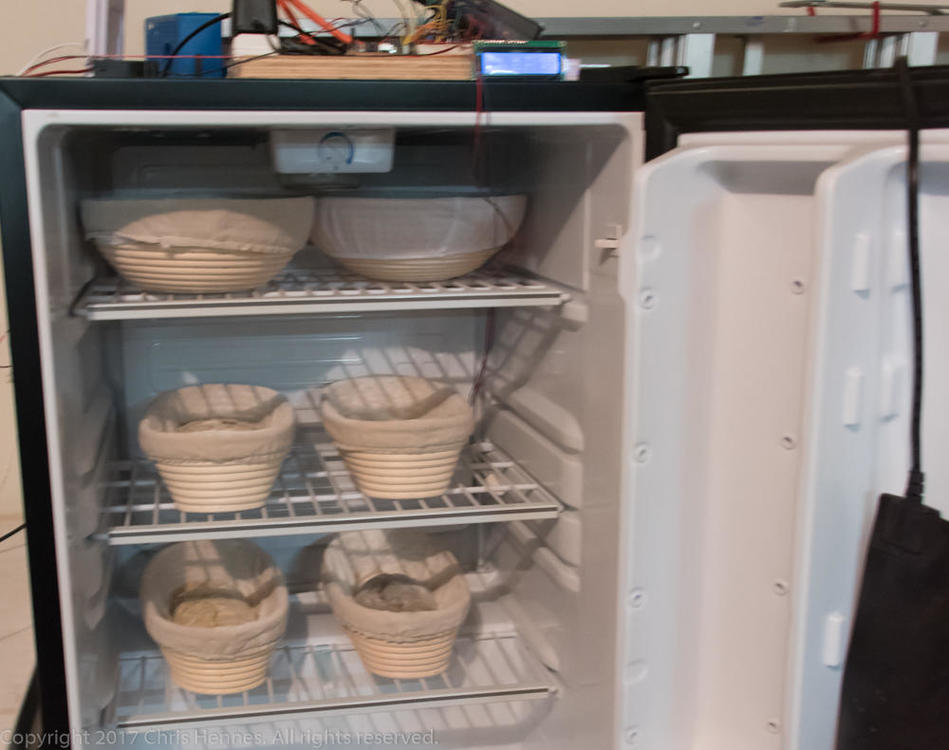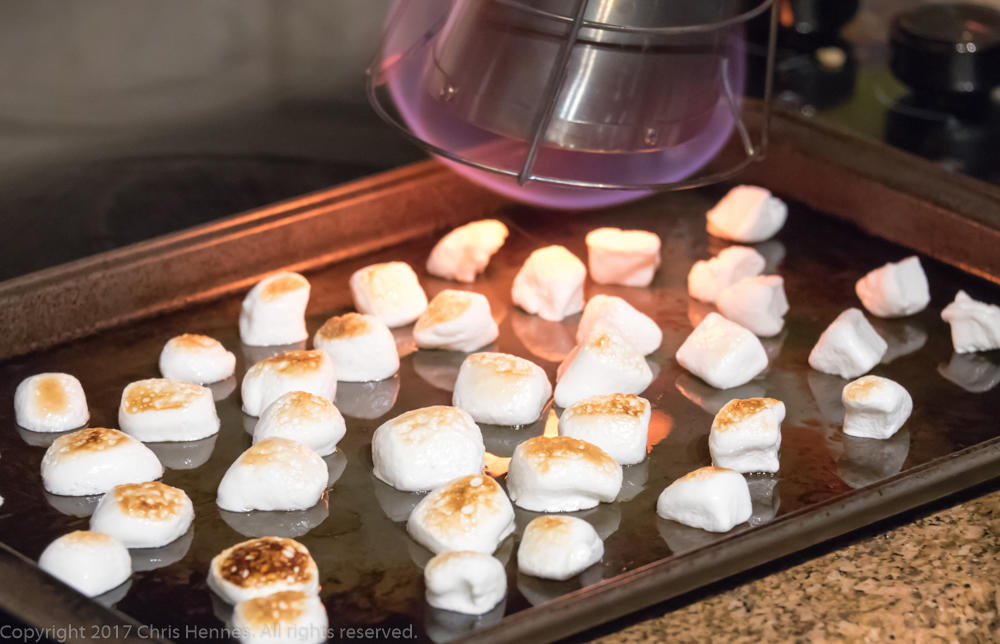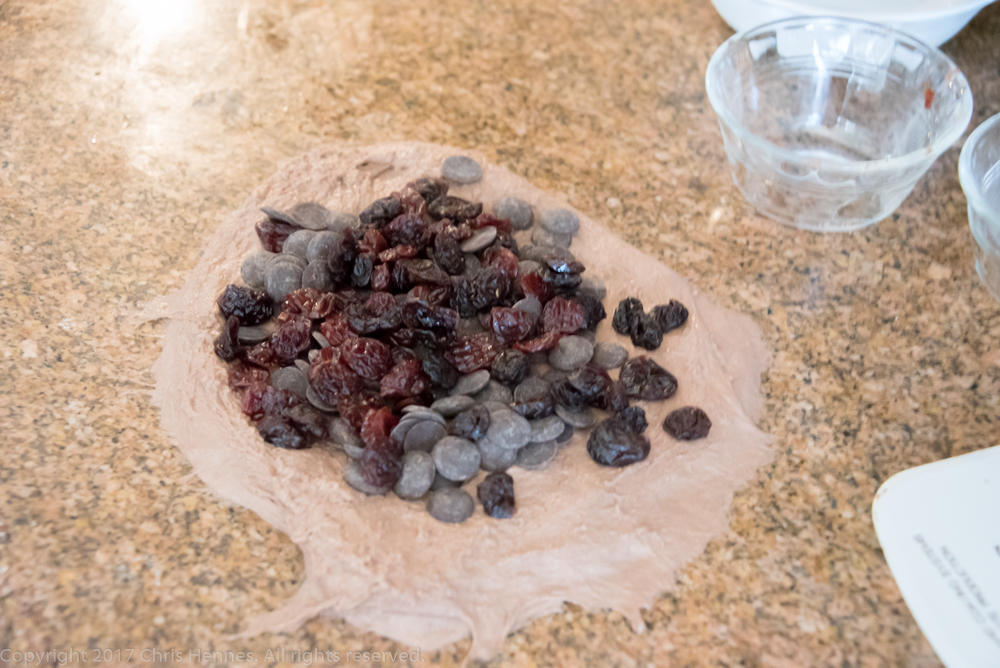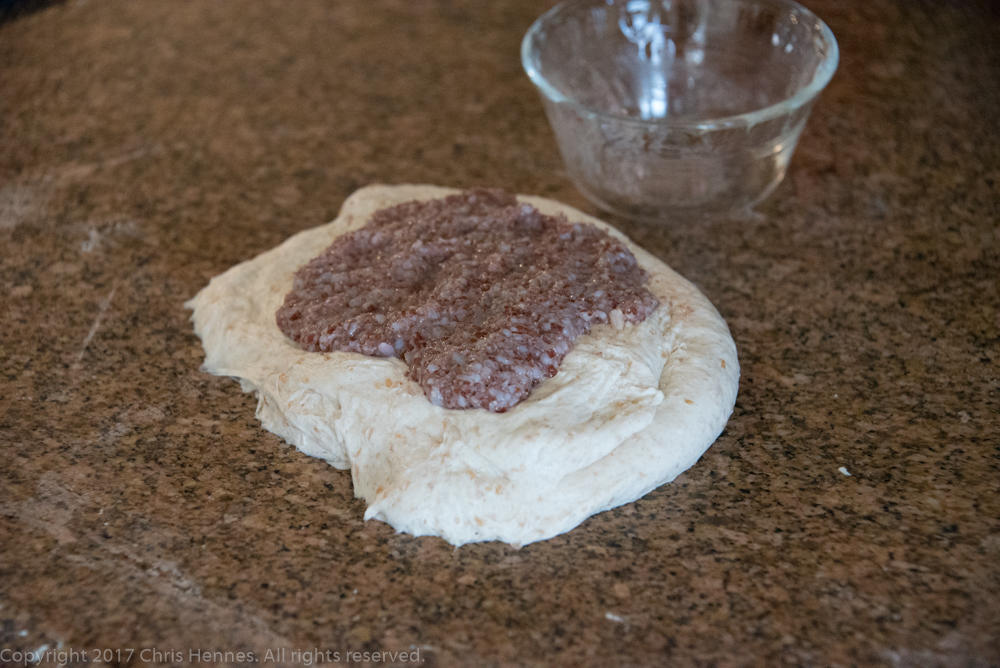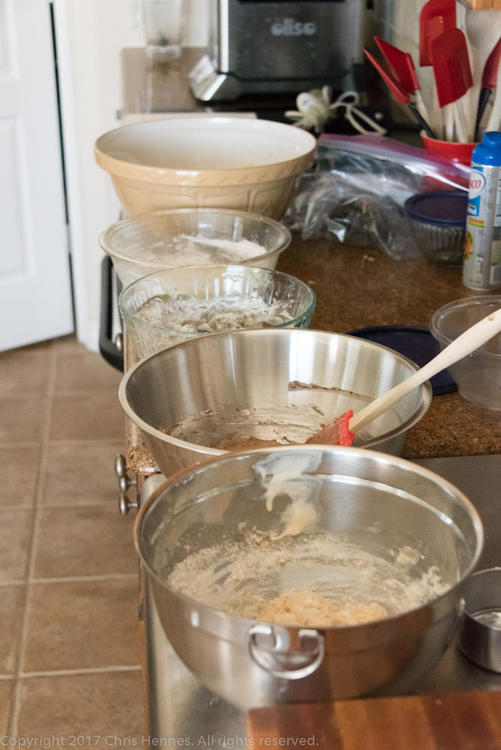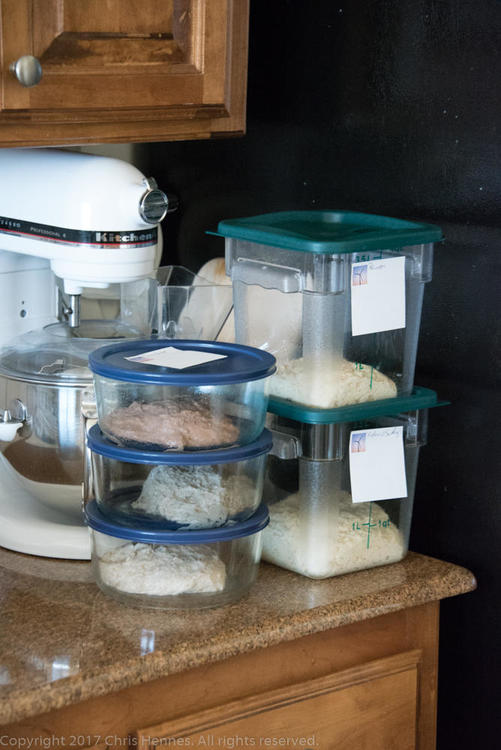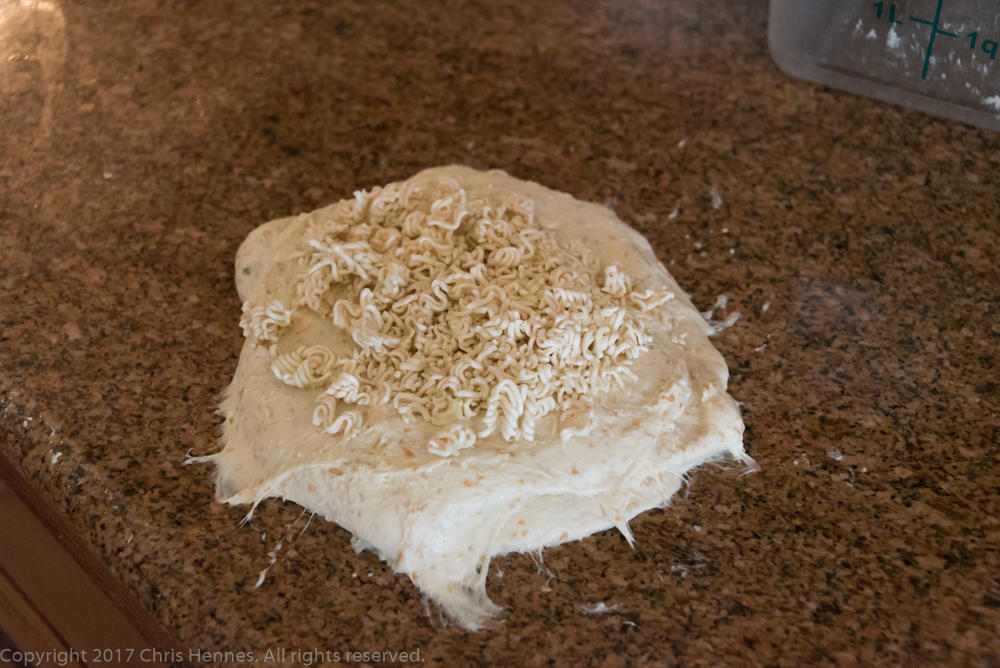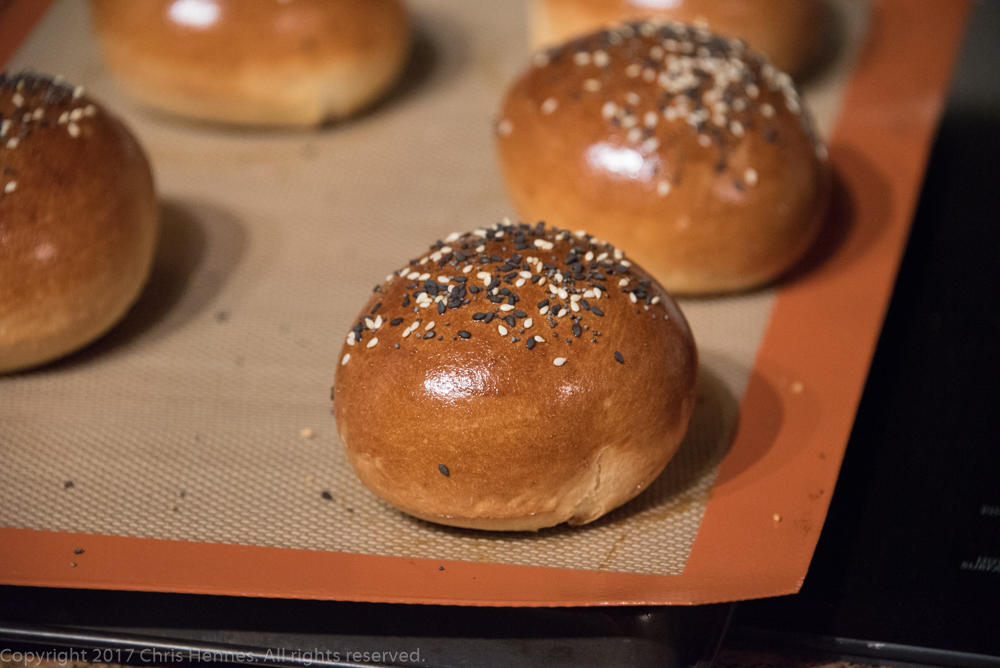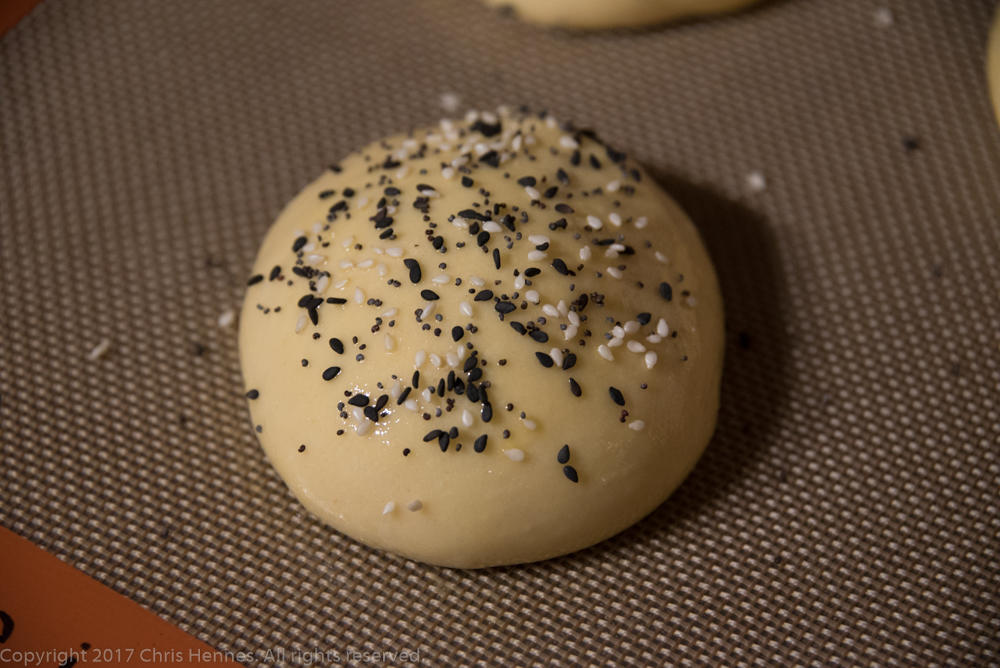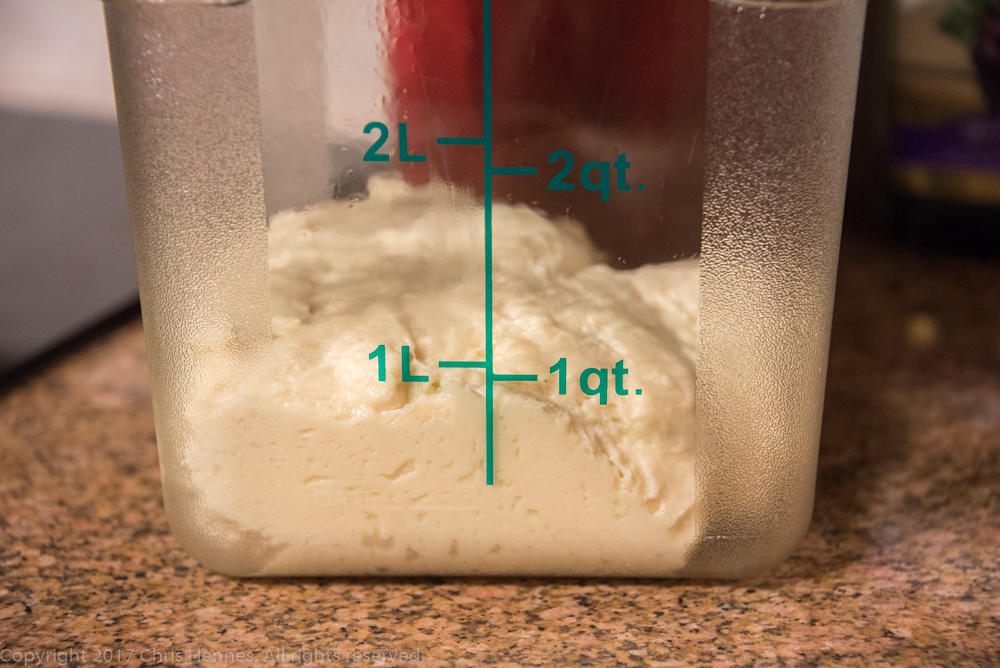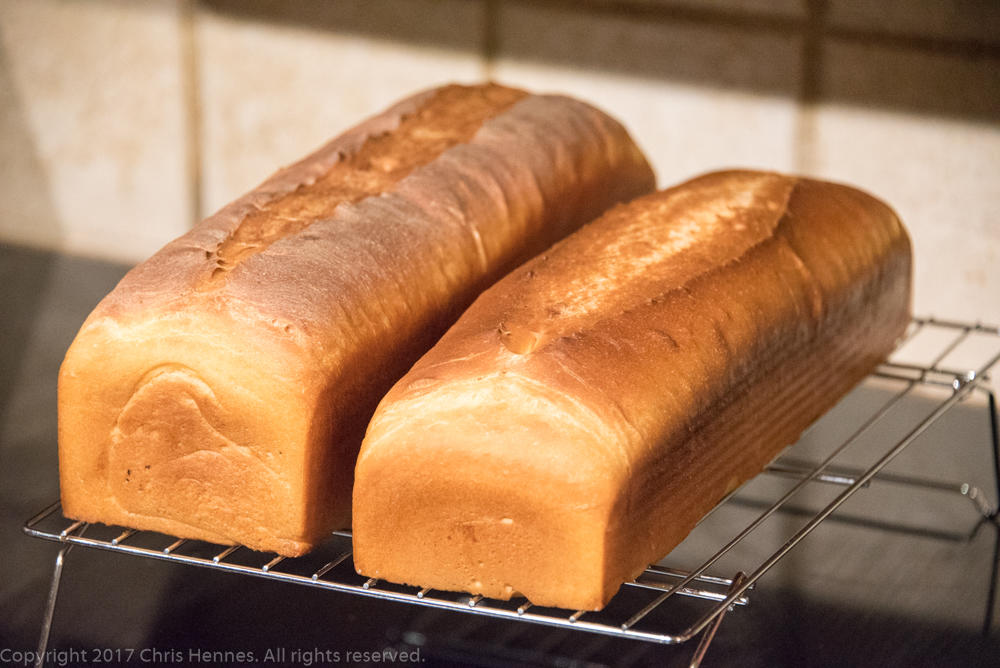-
Posts
10,190 -
Joined
-
Last visited
Content Type
Profiles
Forums
Store
Help Articles
Everything posted by Chris Hennes
-

Baking with Myhrvold's "Modernist Bread: The Art and Science"
Chris Hennes replied to a topic in Pastry & Baking
S'Mores Sourdough The instructions for adding the inclusions here ask you to shape a boule as normal, flatten it slightly, add the fillings, and then gently reform the boule around the filling. For me this process resulted in a filling that was quite close to the top of the boule, so that when I slashed it I exposed the filling. Oops! This made a great mess of my baking stone, and although it smelled great, it does give a pretty ugly loaf. The flavor is fine, but I found that the marshmallows sort of got lost in there. I wonder if you could actually add the marshmallows and chocolate as an inclusion and do just the graham cracker spread as a swirl of sorts? -

Baking with Myhrvold's "Modernist Bread: The Art and Science"
Chris Hennes replied to a topic in Pastry & Baking
Sourdough with Huitlacoche I had lots of leftover huitlacoche puree from my last experiment with this bread, so this time I made the Modernist Sourdough but added the puree per the instructions for the Huitlacoche and yellow corn sourdough. I didn't add the corn this time, and I made the dough a bit higher hydration than last time. I still didn't get the texture I was looking for here, it's coming out a bit too dense. And apparently my shaping was crap, there's a partial tunnel at the bottom. Back to the drawing board... -

Baking with Myhrvold's "Modernist Bread: The Art and Science"
Chris Hennes replied to a topic in Pastry & Baking
Sourdough with Ramen I'm honestly a little disappointed in this one: not because it tastes weird, but because it doesn't! Maybe it's because I'm using a more sour levain than the Modernist team (mine ferments at room temperature, a bit warmer than theirs and so a bit more acidic). Even the texture isn't that far off a completely standard sourdough. Since I only made a single 500g loaf I only used half the flavoring packet. Next time I'm going to use the whole thing. I also wish the ramen had ended up crispy. As it is, it adds a bit of chew to the loaf, but if you're not looking for it I don't know that you'd really notice it. -

Baking with Myhrvold's "Modernist Bread: The Art and Science"
Chris Hennes replied to a topic in Pastry & Baking
Sourdough with Pressure-Caramelized Grains I love this bread. It's basically exactly what I want in a loaf: a good, tangy sourdough with very flavorful, great-textured grain inclusions. It has just a tiny hint of sweetness from the caramelization. I was much more aggressive in mixing the inclusion into the dough this time (which as I mentioned above feels very strange, like you are destroying the gluten structure), but I think it paid dividends in the final texture of the bread. It had great rise and structure and the finished texture is excellent. -

Baking with Myhrvold's "Modernist Bread: The Art and Science"
Chris Hennes replied to a topic in Pastry & Baking
Sourdough with Forbidden Rice Porridge The inclusion of the porridge made this a very slack dough. It was also fascinating to me that it got included after the second fold, not the first, which felt very weird. You basically have this pretty nice sourdough, and then you absolutely destroy it by squishing in this porridge until you have a gloppy mess. I felt like I was back at square one, but four turns later the gluten was very well formed and passed the window pane test with no issues. I'd still be inclined to make the dough stiffer next time, however, it was pretty fluid when I turned it out of the basket to bake, so wound up a sort of strange, flat shape. -

Baking with Myhrvold's "Modernist Bread: The Art and Science"
Chris Hennes replied to a topic in Pastry & Baking
Wow, my house now smells amazing. The s'mores dough totally exploded during baking, spilling copious quantities of cinnamon graham cracker filling onto the baking stone. I don't have much of a sweet tooth, but that smell... Here's a quick preview of this morning's baking activity: -

Baking with Myhrvold's "Modernist Bread: The Art and Science"
Chris Hennes replied to a topic in Pastry & Baking
Nice, @Anna N. I programmed my oven to preheat itself this morning (and it actually did so!) so I've got two of yesterday's loaves in there baking right now. -

Modernist Bread: Direct Country-Style Bread (MB Contest Topic #2)
Chris Hennes replied to a topic in Pastry & Baking
@Eric Srikandan -- what sort of oven are you using? Did you proof free-form, or in a basket or bowl? -

Baking with Myhrvold's "Modernist Bread: The Art and Science"
Chris Hennes replied to a topic in Pastry & Baking
The S'Mores additions have been added to the last dough: Now everything is shaped and proofing at 13°C for 14 hours. -

Baking with Myhrvold's "Modernist Bread: The Art and Science"
Chris Hennes replied to a topic in Pastry & Baking
There is, it's just not so specific with the time. The purpose of that mixing step (according to 4•219) is just to achieve full gluten development, which they explain will depend on your mixer and several other factors, so the time is only approximate. They tell you to do the window pane test to check, rather than just relying on a time. So in the Chocolate Brioche, when they say "mix on medium-high speed to full gluten development," that's the mixing step you are seeing listed as "15-20 minutes" in other recipes. The butter really slows things down, apparently. -

Baking with Myhrvold's "Modernist Bread: The Art and Science"
Chris Hennes replied to a topic in Pastry & Baking
Yeah, I'm intrigued, I can't wait to taste it. Of course, S'Mores aren't S'Mores unless the marshmallows are toasted: (as you can see, I didn't have any mini marshmallows so I used the regular size and cut them into eighths). -

Baking with Myhrvold's "Modernist Bread: The Art and Science"
Chris Hennes replied to a topic in Pastry & Baking
Today I figured since I was going to be hanging out in the kitchen all day anyway I may as well make some bread. So today's lineup is: Chocolate cherry (by popular demand) Pressure-caramelized grains (because I had leftover grains) Ramen (I can't resist, it's too weird) Forbidden rice porridge Huitlacoche S'Mores All of these are sourdoughs, and I'm basing them all off the Modernist Sourdough recipe with the book's suggested modifications. My levain has been a bit anemic these last few days -- my hypothesis is that it's because I changed flour brands, but who knows. Fingers crossed that it's got enough power to leaven these loaves. Here's a shot to give you an idea of the volume of inclusions in the Chocolate Cherry: And the ramen: Here's the secret ingredient there: (and yes, you add the flavor packet to the dough!) Here's the porridge: The autolyse phase (five bowls because the grain inclusion and the S'mores both have the same plain sourdough base): And fully mixed and ready for their first turn: -

Baking with Myhrvold's "Modernist Bread: The Art and Science"
Chris Hennes replied to a topic in Pastry & Baking
This. I've skimmed the whole set now, and read the chapters I (thought I) needed to make the breads I was interested in first, but I'm finding that there are lots of gaps in my knowledge that would have been filled if I'd really read the whole thing before baking. Instead I am still learning by screwing things up and then looking up the answer afterwords. -

Baking with Myhrvold's "Modernist Bread: The Art and Science"
Chris Hennes replied to a topic in Pastry & Baking
The pate fermentée presented in volume 3 uses 0.07% yeast, whereas the one in the recipe for the pain rustique uses 0.67% yeast, basically ten times as much. There's a table on 3•22 that shows how to convert the yeast quantity for the target time you want to let it mature. -

Baking with Myhrvold's "Modernist Bread: The Art and Science"
Chris Hennes replied to a topic in Pastry & Baking
I'd don't have the books handy right now, @Anna N -- what are the flour proportions in that rye recipe? -

Modernist Bread: Direct Country-Style Bread (MB Contest Topic #2)
Chris Hennes replied to a topic in Pastry & Baking
Nice looking loaves! They want you to preheat your oven to the loading temperature, then turn it down to the baking temperature after you put the bread in. -

Baking with Myhrvold's "Modernist Bread: The Art and Science"
Chris Hennes replied to a topic in Pastry & Baking
Well, they are the size of hamburgers, which is a bit big for a dinner roll. But otherwise there’s not much difference when you hand shape and bake without a mold. -

Baking with Myhrvold's "Modernist Bread: The Art and Science"
Chris Hennes replied to a topic in Pastry & Baking
Here are the burger buns before baking: And after: The oven spring on these is really impressive. They could probably have been proofed another fifteen minutes or so, though. -

Baking with Myhrvold's "Modernist Bread: The Art and Science"
Chris Hennes replied to a topic in Pastry & Baking
My wife suggested we have BBQ pork shoulder for dinner on Wednesday when her brother comes to town for Thanksgiving... awesome, another excuse to bake! Tonight I'm making the Modernist Hamburger Buns. I've made the recipe from Modernist Cuisine several times with excellent success, and this one is only slightly different (they omit the lemon oil and vanilla, and use bread flour instead of a soft wheat flour). Here's the dough after mixing to medium gluten formation (it only gets one fold after this, so except for needing a biga it's quite fast to make): -

Baking with Myhrvold's "Modernist Bread: The Art and Science"
Chris Hennes replied to a topic in Pastry & Baking
Yes, I include the liquid. They present this technique is one of this weekend’s recipes. The sandwich loaf maybe? -

Baking with Myhrvold's "Modernist Bread: The Art and Science"
Chris Hennes replied to a topic in Pastry & Baking
Yes, this is definitely true, their salt slurry thing is strange. They have a different technique that they espouse elsewhere where you sprinkle the salt over the shaggy mass (without mixing it in) before the autolyse stage. That's the technique I've settled on, it works well (and I never forget to add the salt ). -

Baking with Myhrvold's "Modernist Bread: The Art and Science"
Chris Hennes replied to a topic in Pastry & Baking
Yes, you do. Or, at least I did! And the ones proofed in the bannetons baked up just beautifully. The difference between 39°F and 65°F is not that large considering you're putting them into a 500°F oven. The trick with the refrigerator is to get the surface of the dough to dry out a bit to give cleaner slashes, so if you proofed in baskets you're going to have to turn the dough out of them first. It's not really Modernist Bread's innovation and as I recall they just mention it in passing. I never do it. -

Baking with Myhrvold's "Modernist Bread: The Art and Science"
Chris Hennes replied to a topic in Pastry & Baking
Last two loaves of the day: each one is a 1kg 4x4x13 loaf of the white sandwich bread, destined to be turned into stuffing on Thursday. This was an interesting experiment. I made these two loaves in succession (I only have one pan that size), so they were actually made separately rather than as a single batch that was divided. The difference between the two? In the first one was the last bit of yeast from a jar I'd been using for years and stored in the freezer. The second loaf (the smaller of the two, on the right: the one that is obviously underproofed) was made with a new, unopened jar of yeast whose expiration date was last month. It was on clearance, so I figured if it turned out to be a flop I'd just pitch it. Well, instead what happened was it needed longer to proof and I got into a hurry so baked it off early, when I should have been more patient. Oh well, I'm sure it will be fine in stuffing. -

Baking with Myhrvold's "Modernist Bread: The Art and Science"
Chris Hennes replied to a topic in Pastry & Baking
I'm glad you tried this, it's definitely on my list. I generally like the taste of whole wheat, but would like more control over it. The "deconstructed" process they present is a great idea, particularly as most whole wheat flours are really just reconstructed after milling in the same way, I think. -

Baking with Myhrvold's "Modernist Bread: The Art and Science"
Chris Hennes replied to a topic in Pastry & Baking
It does, you just have to know exactly what they call it (which I didn't remember when I was posting earlier -- sorry!): here it is... https://www.bobsredmill.com/whole-grain-medley.html


